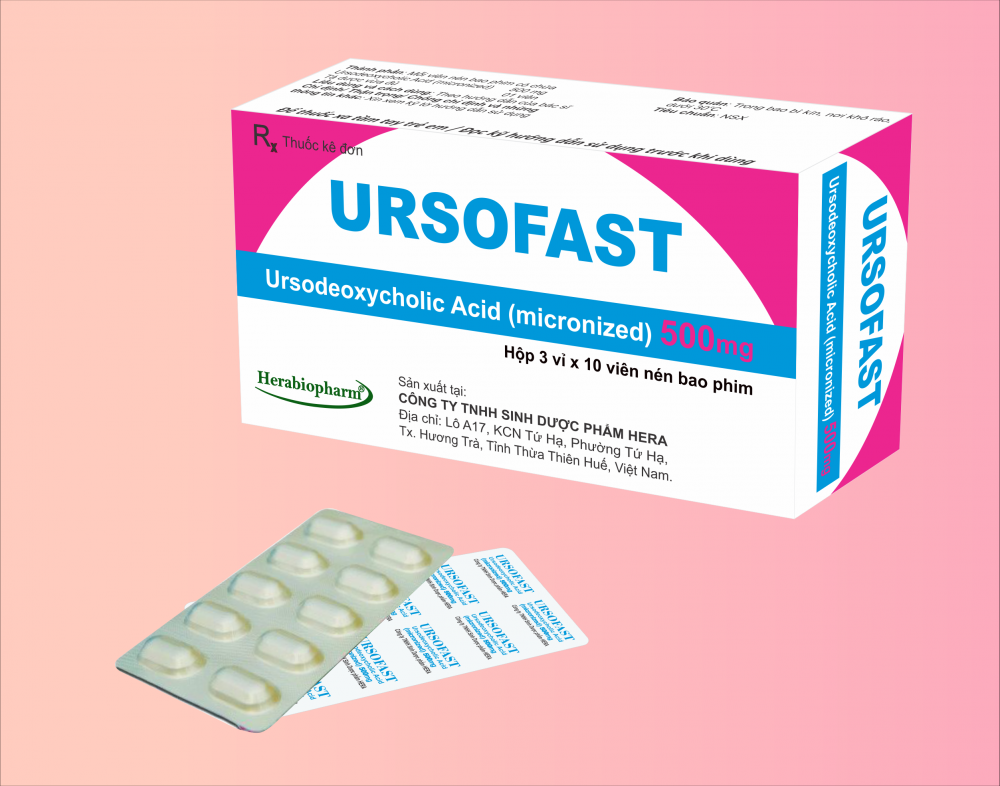URSOFAST
- Packing3 blister packs of 10 tablets
- Shelf life36 months
- CompositionUrsodeoxycholic acid 500 mg
- Posology and pharmaceutical formFilm-coated tablet
- Product codeUpdating.....
Summary of product characteristic
-
Indications, posology and method of administration
THERAPEUTIC INDICATIONS
For the treatment of primary biliary cirrhosis (PBC), provided there is no decompensated hepatic cirrhosis.
For the dissolution of cholesterol gallstones in the gall bladder. The gallstones must not show as shadows on X-ray images and should not exceed 15 mm in diameter. The gall bladder must be functioning despite the gallstone(s).
Paediatric population:
Hepatobiliary disorders associated with cystic fibrosis in children aged 6 to 18 years.
POSOLOGY AND METHOD OF ADMINISTRATION
There are no age restrictions on the use of ursodeoxycholic acid tablets in the treatment of PBC and for the dissolution of radiolucent gallstones.
The following daily dose is recommended for the various indications:
For the treatment of primary biliary cirrhosis (PBC):
The daily dose depends on body weight and ranges from 1½ to 3½ tablets (14 ± 2 mg of UDCA per kg of body weight). For individuals weighing less than 47 kg, consider the product ursodeoxycholic acid 300 mg film-coated tablets or other products with the same active ingredient. For the first 3 months of treatment, ursodeoxycholic acid tablets should be taken divided over the day. With improvement of the liver values the daily dose may be taken once daily in the evening.
| Body weight (kg) |
Daily dose (mg/kg) |
Film-coated tablets |
| First 3 months |
Subsequently |
| Morning |
Midday |
Evening |
Evening
(1 x daily) |
| 47 – 62 |
12 – 16 |
½ |
½ |
½ |
1½ |
| 63 – 78 |
13 – 16 |
½ |
½ |
1 |
2 |
| 79 – 93 |
13 – 16 |
½ |
1 |
1 |
2½ |
| 94 – 109 |
14 – 16 |
1 |
1 |
1 |
3 |
| Trên 110 |
|
1 |
1 |
1½ |
3½ |
The tablets should be swallowed with some liquid. The tablets should not be crushed or chewed. Care should be taken to ensure that they are taken regularly.
The use of ursodeoxycholic acid tablets in PBC may be continued indefinitely.
For dissolution of cholesterol gallstones:
Approximately 10mg of UDCA per kg of body weight, equivalent to:
| ≤ 60 kg |
1 tablet |
| 61 – 80 kg |
1½ tablets |
| 81 – 100 kg |
2 tablets |
| Over 100 kg |
2½ tablets |
The tablets should be swallowed with some liquid in the evening at bedtime. The tablets should not be crushed or chewed. The tablets must be taken regularly.
The time required for dissolution of gallstones is generally 6-24 months, depending on stone size and composition. If there is no reduction in the size of the gallstones after 12 months, the therapy should not be continued.
The success of the treatment should be checked by means of ultrasound or X-ray examination every 6 months. At the follow-up examinations, a check should be made to see whether calcification of the stones has occurred in the meantime. Should this be the case, the treatment must be ended.
The likelihood of recurrence of gallstones after dissolution by bile acid treatment has been estimated as up to 50% at 5 years. The efficiency of ursodeoxycholic acid in treating radio-opaque or partially radio-opaque gallstones has not been tested but these are generally thought to be less soluble than radiolucent stones. Non-cholesterol stones account for 10-15% of radiolucent stones and may not be dissolved by bile acids.
Older people: In both indications there is no evidence to suggest that any alteration in the adult dose is needed but the relevant precautions should be taken into account.
Paediatric population: Both indications are very rare in children and adolescents. Therefore, there are no adequate data on the efficacy and safety in this population.
The administration of ursodeoxycholic acid is based on body weight and the medical condition.
For the treatment of hepatobiliary disorders associated with cystic fibrosis:
Paediatric population:
Children with cystic fibrosis aged 6 to 18 years: 20 mg/kg/day in 2-3 divided doses, with a further increase to 30 mg/kg/day if necessary.
| Body weight (kg) |
Daily dose
UDCA (mg/kg) |
Ursodeoxycholic acid 500 mg film-coated tablets |
| Morning |
Midday |
Evening |
| 20 – 29 |
17 – 25 |
½ |
-- |
½ |
| 30 – 39 |
19 – 25 |
½ |
½ |
½ |
| 40 – 49 |
20 – 25 |
½ |
½ |
|
| 50 – 59 |
21 – 25 |
½ |
1 |
1 |
| 60 – 69 |
22 – 25 |
1 |
1 |
1 |
| 70 – 79 |
22 – 25 |
1 |
1 |
1½ |
| 80 – 89 |
22 – 25 |
1 |
1½ |
1½ |
| 90 – 99 |
23 – 25 |
1½ |
1½ |
1½ |
| 100 – 109 |
23 – 25 |
1½ |
1½ |
2 |
| ≥ 110 |
|
1½ |
2 |
2 |
CONTRAINDICATIONS
Ursodeoxycholic acid tablets should not be used in patients with:
- Presence of calcified, radio-opaque gallstones.
- Acute cholecystitis or cholangitis.
- Bile duct obstruction (obstruction of the cystic duct and common bile duct).
- Frequent biliary colic episodes.
- Impaired gallbladder contractility.
- Hypersensitivity to bile acids or any other component of the medication.
- Do not use the drug if bile duct surgery is unsuccessful or if bile flow cannot be restored in children with biliary atresia when treating liver diseases related to cystic fibrosis in children aged 6 – 18 years.
This information is for reference only. Please read the leaflet inside
